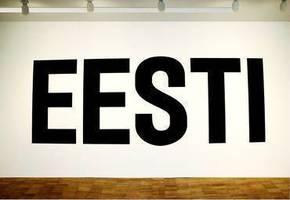VIZUĀLO MĀKSLU PORTĀLS
|
|
|
Kur iegādāties? Iegādāties iepriekšējos Nr. Par mums
| Izstāde "Parunāsim par nacionālismu! Starp ideoloģiju un identitāti" Tallinā Marika Pärn, Eesti Kunstimuuseum 04.02.2010 - 25.04.2010 On Thursday, 4 February at 6 p.m., the exhibition Let’s Talk About Nationalism! Between Ideology and Identity will open on the fifth floor of the Kumu Art Museum, in Tallinn, Estonia. On the opening day, artist talks with Joanna Rajkowska (at 12 p.m.), Jens Haaning (at 2 p.m.) and Csaba Nemes (at 4 p.m.) will take place at the Education Centre in Kumu. | ||||||||||
 Jens Haaning. Eesti. 2010. Wall text at Kumu Art Museum, Tallinn, Estonia | ||||||||||
| The international exhibition of contemporary art has grown out of the “Public Preparation” event series, which has been focused on the problems of nationalism since 2008. The exhibition is curated by Rael Artel. The purpose of the exhibition is to ask critical questions about nationalism here and now, in 21st century Estonia and Europe. The artists investigate the complex cultural-political process during which nationalistic ideology is transformed into national identity. Participating artists: Nanna Debois Buhl (Copenhagen / New York), Jens Haaning (Copenhagen), Raul Keller (Tallinn), Eva Labotkin (Tallinn/Tartu), Tanja Muravskaja (Tallinn), John Phillip Mäkinen (Helsinki), Csaba Nemes (Budapest), Audrius Novickas (Vilnius), Danilo Prnjat (Belgrade), Johannes Paul Raether (Berlin), Joanna Rajkowska (Warsaw), R.E.P. Group (Kiev), Twożywo (Warsaw), Shlomi Yaffe (Prague), Katarina Zdjelar (Rotterdam) and Artur Żmijewski (Warsaw) It is difficult to overrate the topical nature of national issues. In the local Estonian cultural space, some of the events that have caused the greatest confrontations, anger and violence in recent years have been conflicts over monuments that perpetuate different treatments of history. From Europe and the world come constant stories of illegal immigrants and the Schengen visa space, as well as news of right-wing extremists and racially motivated crimes committed by neo-Nazis. Who can live in Estonia and Europe and under what conditions? Who has the right to have a say in local matters? Who can demand political rights and who must simply be content with the opportunity to earn and to consume? Living in our little sovereign state, with its decreasing population, in our microscopic national cultural space, we might be tempted to ask: why even question Estonian nationalism? Why organize an exhibition on this issue? The answer is logical, but also uncomfortable and unpleasant: Estonian nationalism, at first glance so natural and justified, also leads to segregation, discrimination, suffering and violence. Nationalism affects every country, even when the violence does not occur directly on the streets, but rather is hidden or institutionalized. The nationalist way of thinking has been welded into the collective mentality to such an extent that casting any doubts on it is seen as inappropriate. The exhibition Let’s Talk About Nationalism! Between Identity and Ideology dares to raise doubts and invites us to once again review the mechanisms of collective self-awareness in the context of the contemporary world. A number of internationally active artists working primarily from a critical approach have been asked to participate in this exhibition and to display both earlier works and pieces that have been adapted to the Estonian cultural context or made specifically for the Kumu Art Museum exhibition. This exhibition will cast doubt on the truths of dominant national agendas which are spared (self)criticism, and will approach the topic of contemporary nationalism from many different sides. Considering the needs of an art museum geared to a wider audience, we have avoided focusing on a narrow aspect of the issue and have instead decided to create a more panoramic picture. The works displayed in the project are conditionally divided into three groups: ideological habits, reproduction of the nation, and conflicts. There are no complete answers or standard solutions at this exhibition – just questions. The choice of works might be characterized as a selection that is as open as possible and maps the area to the widest possible extent. Each work here is a potential premise for wider discussion. The exhibition has been fully translated into Estonian, Russian and English. A catalogue-guide, in three languages, will be published, and it will lead the viewer through the exhibition and introduce each work in detail, as well as the general concept of the exhibition. The catalogue is edited by Rael Artel, designed by Jaan Evart, and published by the Art Museum of Estonia. The catalogue is free. Exhibition curated by Rael Artel. A thorough education programme, supported by the Open Estonia Foundation, will accompany the exhibition. There will be a parallel programme of documentaries, “Public Preparation Screenings,” in the Kumu auditorium: 9 February at 6 p.m. The State of Exception Proved to Be the Rule. Dir. Eduard Freudmann and Jelena Radić, Serbia, 2008, 84 min. In Serbian, with English subtitles. 9 March at 6 p.m. Rocking The Nation. Dir. Borbala Kriza, Hungary, 2007, 70 min. In Hungarian, with English subtitles 30 March at 6 p.m. Letter from Moldova. Dir. Joanne Richardson, Romania, 2009, 28 min. In Romanian, with English subtitles; Red Tours. Dir. Joanne Richardson and David Rych, Romania/Germany, 2010, 50 min. Different languages, with English subtitles A series of discussions, meetings and artist talks will take place during the exhibition in the Public Preparation Social Club (in the education room, on the 5th floor of Kumu). Additional information in media and mailing-lists. The reader Public Preparation – Contemporary Nationalism and Critical Art Practices will be published during the exhibition (see www.publicpreparation.org). The exhibition is supported by the Open Estonia Foundation, the Cultural Endowment of Estonia, the Estonian Academy of Arts, the Estonian Ministry of Culture, the Goethe Institute, the Lithuanian Ministry of Foreign Affairs, the Mondriaan Foundation, the Embassy of the Republic of Poland in Tallinn, Public Preparation, the Finnish Institute and the Hungarian Institute. | ||||||||||
| Atgriezties | ||||||||||
| ||||||||||








